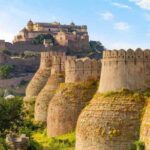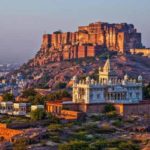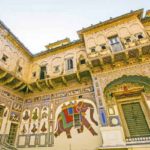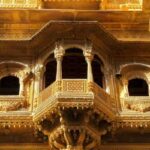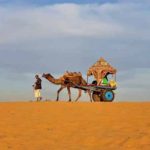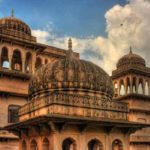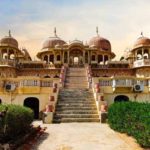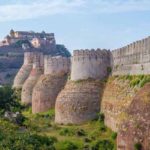16 Must See Monuments In Rajasthan the desert state of Rajasthan has some of the world’s most majestic and evocative monuments. The medieval grandeur and majestic palaces, exquisite and richly sculpted temples, and imposing monuments in Rajasthan are preserved in Rajasthan as testimony to some of the finest works of the civilization of Rajput. Among the state’s many tourist attractions, the ancient monuments in Rajasthan rank first. From all over the world, these ancient palaces and mansions attract hordes of visitors to Rajasthan. Right from the great forts to fascinating palaces and from the immense ‘havelis‘ (mansions) to the magnificent temples, The monuments in Rajasthan add to the state’s magnetic charm.
These buildings, commonly known for their architectural splendor, owe their execution to the ingenuity of great rulers of the past who dared to stretch their ideas to the farthest reaches of human thinking. A Rajasthan Monuments Tour brings out the real essence of Rajput pride, romance, culture and glory. Rajasthan’s monuments reverberate with the tradition of heroism and sacrifice, and they are living reminders of the state’s royal past. The aesthetic sense of the medieval Rajput warriors is really reflected in these heritage buildings. The Rajasthan Temples are outstanding embodiments of the state’s glorious architectural heritage.
For decades, the ruins of these Rajasthan temples have continued to fascinate art lovers and travelers of all kinds. The major cities where a significant concentration of the Rajasthan Monuments are located are Jaipur, Jodhpur, Udaipur, Jaisalmer, Bikaner and Chittorgarh. Also the smaller and more isolated towns and villages, however, boast enough monumental heritage to enthrall visitors. In reality, in order to gain an in-depth insight into Rajasthan’s history and culture, these less-famous destinations need to be further explored. Each of the Rajasthan monuments tells a distinctive tale from the folds of its history.
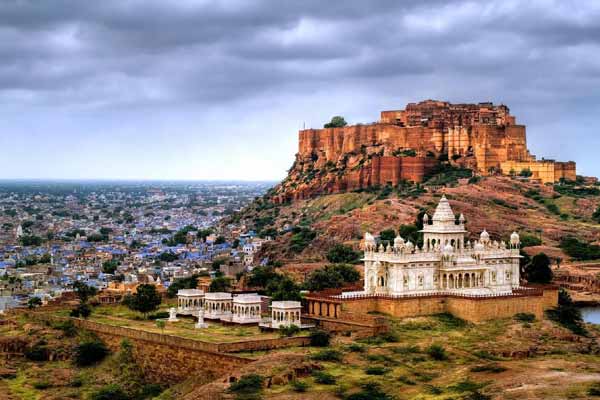
Most of Rajasthan’s monuments are embossed with intricate works of art. These monuments, evocative of the sculpting and architectural perfection of the ancient Rajputs, represent the love of opulence and elegance in the ancient Rajputs’ hearts. In many of these monuments, the architectural style reflected is entirely Rajputana, while some display a fine blend with other styles, particularly Mughal. Rajasthan monuments‘ exquisite interior decoration, complete with paintings, mirror work, portraits, carvings, etc., add perfect elegance to the image of these sites 16 Must See Monuments In Rajasthan.
While most of Rajasthan’s monuments gave expression to the immense passion of the rulers of yesteryear for art and architecture, With its golden sands, awe-inspiring bastions, ancient havelis, camel safaris and magnetic charm, Rajasthan invites you to come and look for historical secrets from inside the precincts of its monuments. But they had some very vital reason for their construction such as protective, religious and accommodation. In Rajasthan, visit the monuments and you will certainly be captivated by their exquisite beauty and heritage.
Plan your Monuments Tour through Vibrant Rajasthan in Rajasthan and experience a multitude of world-class monuments.
Popular Monuments in Rajasthan
16 Must See Monuments In Rajasthan, particularly if you are planning a trip to the royal state of Rajasthan, can be relaxing and enjoyable. This awe-inspiring state is always charming, its towns full of monuments are tourist-friendly, the hills are picturesque and the lakes are scenic. In Rajasthan, enjoy the best vacation by visiting its beautiful forts and palaces. Here is the list of Rajasthan’s 16 must-see monuments.
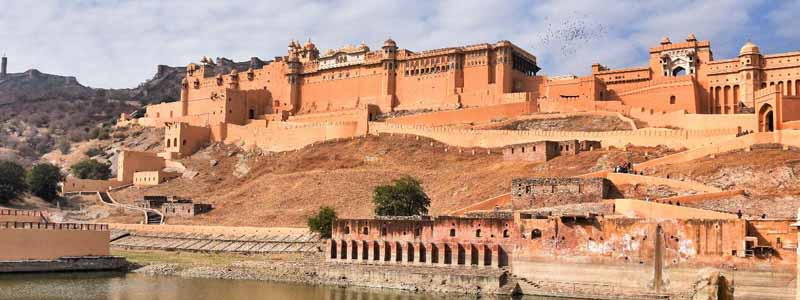
1. Amer Fort – Jaipur – A grant monument in Rajasthan
In Amer, near Jaipur, Amer Fort or Amber Fort is situated. This heritage site is one of Rajasthan’s most prominent forts and one of the most visited tourist places in Jaipur. It is also one of Rajasthan’s best preserved historical places to visit and one of the prime places to visit on a tour of Jaipur.
In 967 AD, the Meenas founded Amber and dedicated the town to Amba, the Mother Goddess. Amber was conquered by Kachhawa Rajputs around 1037 AD and ruled it from the 11th to the 18th centuries, until the capital was shifted from Amer to Jaipur. In 1592 AD, the Amber Fort was built by Raja Man Singh and successive rulers expanded it further. Man Singh was one of Emperor Akbar’s trusted generals and one of the Navaratnas of his court. This fort is often referred to as the Amer Palace quite popularly. Sawai Jai Singh II later moved the capital from Amber to Jaipur in 1727 AD.
Amer Fort’s architecture is inspired by Hindu as well as Muslim designs. The fort was built using red sandstone and overlooks Maota Lake, which is the Palace’s main source of water. The Palace consists of four main parts, each with its own entrance gate and courtyard. The Suraj Pole (Sun Gate), which leads to Jaleb Chowk, is the main entrance. This was the spot where, on their return from fighting, armies would conduct victory parades with their war bounties. It was facing east toward the rising sun, hence the Sun Gate name. From Jaleb Chowk, an impressive stairway leads into the main palace grounds. This is where Shila Devi Temple and Ganesh Pol are situated.
The Diwan-i-Am and the Public Audience Hall are located in the second courtyard. The Diwan-i-Am is a raised platform with 27 columns, built with a double row of columns, Each of which has an elephant-shaped capital mounted, with galleries above it. This was the place where the general public met to discuss their complaints and meet the King.
The third courtyard is where the Maharaja’s private quarters, his family and attendants were situated. Through the Ganesh Pol or Ganesh Gate, which is decorated with mosaics and sculptures, you enter this courtyard. There are two buildings in the courtyard, one opposite the other, divided by a garden laid out in the Mughal Gardens fashion.
One of the main attractions of Amer Fort is the Sheesh Mahal or the Mirror Palace. Sheesh Mahal’s ceiling and walls are engraved with countless mirror pieces with exquisite floral paintings on them. At night, when candles were lit in the bed, because of the reflection of the mirrors, the entire room looks like a sky filled with stars.
The Sukh Mahal is the other building seen in the courtyard (Hall of Pleasure). Sukh Mahal’s impressive giant doors are made of ivory and sandalwood. There is a water channel that runs through the space, carrying cool water that acts as an air cooler. The place where the Kings used to spend time with their queens was Sukh Niwas. The Palace of Man Singh I, which is the oldest part of the fort, lies south of this courtyard 16 Must See Monuments In Rajasthan.
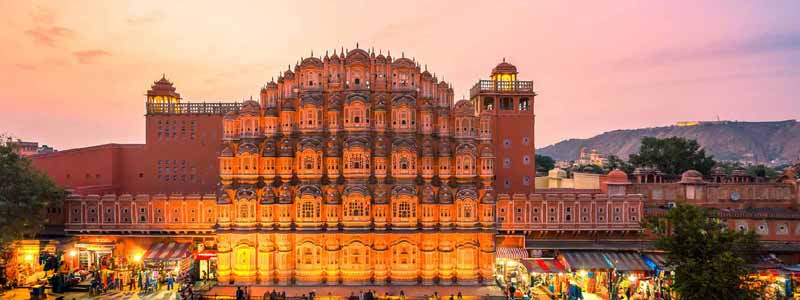
2. Hawa Mahal – Wind Palace (Jaipur) – A 5-storeyed architectural splendor
In Jaipur District, Hawa Mahal is one of the prime tourist places to visit. The palace sits on the edge of the Palace of the City and extends to the chambers of the Zenana (women). In the promotion of Jaipur Tourism, Hawa Mahal is always portrayed. Among the top places to visit near Delhi is Jaipur.
In 1799, as a continuation of the stunning City Palace, Maharaja Sawai Pratap Singh designed the renowned Hawa Mahal or the Palace of Winds. Lal Chand Ustad is the main architect of this palace and the palace is believed to have been built in the shape of Krishna’s crown, the Hindu God.
Hawa Mahal was designed in the architectural Rajputana style. The palace is built of stunning red and pink sandstone and looks like a pyramid of five levels. The palace is situated on a podium that is fifty feet from the foundation. Its unusual five-storey exterior has 953 small windows decorated with intricate latticework called jharokhas. The original purpose of the lattice was to allow royal ladies without being seen to observe daily life in the street below. Cold air reaches the palace through these windows and makes the inner climate cool and friendly.
The palace entrance is a door that opens up to a special courtyard surrounded by a number of two-story buildings. The top three storeys of the five storeys of the Mahal have the thickness of a single space, while the lower storeys have courtyards. The palace’s interior is rather beautiful. It is possible to enter the upper floors of the palace by ascending the steep ramps. Within the Hawa Mahal, there are no staircases 16 Must See Monuments In Rajasthan.
The Archaeological Department now manages the palace. In the Hawa Mahal palace, there is a small museum that houses ancient objects related to the Rajput lifestyle. One can get an outstanding view of Jaipur City from Hawa Mahal.
3. Abhaneri – A charming village with a renowned stepwell
Initially, Abhaneri was called Abha Nagri, which means “city of brightness,” but the name was changed due to mispronunciation. The city is now in ruins, but visitors from all over the world are drawn to it.
For ‘Baoris‘, step wells that were invented to harvest rain water by the natives, Abhaneri is prominent. During parched times of the year, these tanks were used as cool places of refuge and as water reservoirs. The most famous of the wells in the area is Chand Baori, and it is one of the deepest and largest in India.
Using the steps, which are divided into tales, there are three ways to enter the water. In front of the Harshat Mata temple, this colossal, delicately carved well is situated. Before entering the adjoining temple, washing hands and feet at the well was a ritual.
The Temple of Harshat Mata, dedicated to the goddess Harshat Mata, serves as the other Abhaneri tourist attraction. Razed by Islamic rulers in the 10th century during the conquest of India, the ruins of the temple still boast the architectural and sculptural styles of ancient India. The goddess of joy and happiness is known to be Harshat Mata. The goddess is always happy, according to the story, and she conveys her joy and happiness to the entire village.
4. Mehrangarh Fort, Jodhpur – A grand fort with exquisite architecture
Thanks to its magnificent architecture and the diverse past associated with it, Mehrangarh Fort holds the pride of place in Jodhpur. Mehrangarh Fort was founded by Rao Jodha in 1459 and is considered one of Rajasthan’s most formidable and majestic forts. The fort is spread over an area of 5 km and is situated in the suburbs of Jodhpur town on a 125 m high hill.
There are seven gates that can be used to reach the Fort of Mehrangarh. These seven gates were made by various rulers and were constructed in honor of the victory over the armies of Bikaner and Jaipur.
From this fort, which seems like a blue carpet laid at the foot of a hill, one can see a panoramic view of the city of Jodhpur. Every Jodhpur ruler contributed to the development of this fort. One can see the splendid palaces inside the fort. Moti Mahal, Phool Mahal, Sheesh Mahal, Zenana Dude, Takht Vilas and Jhanki Mahal are the main palaces located in Mehrangarh Fort. Within the fort, there are also two temples – Chamundi Devi Mandir and Nagnechiaji Mandir, respectively dedicated to Goddess Durga and Kuldevi.
The Mehrangarh Fort also houses a museum with a rich collection of palanquins, musical instruments, royal cradles, costumes, weapons, furniture and paintings.
5. Chittorgarh Fort – the largest fort in Rajasthan
Whether it’s fairy tales, bloodshed, honor, envy, Chittorgarh Fort has seen every step of the legacy of Rajputana. Considered to be Asia’s largest fort (area wise), it was built by the Maurya rulers in the 7th century. Serving as an incarnation of the Rajputs’ chivalry and honor, this fort was home to many rulers. It is spread over an area of 700 acres and is 3 km long and 13 km long in peripheral length. The impregnable castle, standing on an elevated 180m hill, has experienced three wars.
At Chittorgarh Fort, one can see glimpses of royal Rajput rituals. It can be accessed through seven gates composed of iron spikes, i.e. Ram Pol, Padal Pol, Bhairon Pol, Ganesh Pol, Lakshman Pol, Jorla Pol, and Hanuman Pol. Some of the famous Rajput architecture is also housed in this fort, such as the Rana Kumbha Palace, Padmini Palace, Sammidheshwara Temple, Jain Temple, Kalika Mata Temple, Neelkanth Mahadev Temple, Meerabai Temple, and Kumbha Shyam Temple. These are ancient temples with prominent carvings and complicated work 16 Must See Monuments In Rajasthan.
Established by the Mauryas centuries ago, this land is a witness to the beauty of Queen Padma and has witnessed Allahudin Khilji’s vengeance. A part of Chittorgarh fort is also the Gaumukh reservoir and Bhimtal Tank. Within the vicinity of the fort, there are two famous towers that represent the victory of Rajput, e.g. Vijay Stambh and Stambh Kirti.
6. Vishnoi Village Safari, Jodhpur – A place to experience the tribal life of Rajasthan
The Bishnoi Village is a small village and has always been a tourist attraction during the times of the Indian kingdoms, even for kings. The Bishnoi Village’s original tribe, the Marwar, has influenced the way the village’s culture has been dramatically developed, and you can still see the awe-inspiring influences of their culture as a visitor.
Without too much worldly knowledge, the Bishnoi community consists of simple locals, but they are always ready to learn, and they are renowned for inviting visitors to spend time with them. They are just as open to sharing with their visitors snippets of their history, through their ancestors’ stories, insights into their everyday lives, and through their arts and culture.
While impressive, the village is a small one, and it is almost as if time still stands here. As mentioned before, it is not new for locals to draw tourists, and there is a ‘village safari’ tour available for visitors, initially started by the kings of Jodhpur (the Rajas and the Maharajas), to give visitors an insight into the extraordinary lives of ordinary locals. Tourists are free to embark on either a jeep or a camel-back safari and observe various parts of the village.
There are numerous attractions in the village itself, such as the ‘potters’ village’ and the ‘weavers’ village, where you can visit different societies connected to these occupations in essence. You may also visit Khejarli, where hundreds of villagers sacrificed their lives to save trees from being cut down, the bird-watching village of Gudha, the Lake of Guda Bishnoi and the Village of the Shepherd. The safari takes you through these attractions, whether on a camel-back or in a jeep.
The village is part of the Western Thar Desert and the vegetation consists of Khejri trees and sometimes bushes in and around the village. You will spot birds such as partridges, peacocks, the Great Indian Bustard, and animals such as blackbucks, chinkaras, and the area is full of wildlife. The Bishnoi defend their wildlife aggressively against poachers and hunters 16 Must See Monuments In Rajasthan.
7. Jaisalmer Fort – A stunning landmark of Jaisalmer
Jaisalmer Fort If you want to see the replica of the fort, which was seen in the Arabian Nights television cartoon, then the place to be is Jaisalmer Fort. Jaisalmer Fort is the most prominent landmark in the city of Jaisalmer and is one of the largest forts in the world. Jaisalmer Fort houses museums, stores, restaurants, residential accommodations, hotels, etc., unlike other Rajasthan forts.
Constructed in 1156, the fort is a proud chattel of the Bhati clan. Rawal Jaiswal was the founder of the town of Jaisalmer, and during his reign, Jaisalmer Fort was built. It is a fort that is 250 feet high and is surrounded by walls 30 feet deep. The fort is made up of 99 strongholds, of which 92 were built between 1633 and 1647. One can see the convergence of the architecture of Islam and Rajput. To enter this fort, there are 4 gateways, i.e. Ganesh Pol, Suraj Pol, Akshya Pol, and Hawa Pol. On Trikuta Hill, Jaisalmer Fort is located and has been the scene of many wars.
Raj Mahal (Royal Palace), Jain temples and the temple of Laxminath are the main attractions within the fort. The fort is built according to the latest Rajasthan norms and has a town with a red-and-yellow backdrop.
The Fort of Jaisalmer is one of the world’s few living monuments and is home to a fourth of the population of the city. For all travelers, and especially photographers, the view of the sunset from this fort is a treat for the eyes. Since it is made of yellow sandstone, Jaisalmer fort is popularly known as the “Sonar Kila” In the early morning, the fort looks golden as the first rays of the sun hit the horizon. In the fairy tales, Jaisalmer Fort looks like a castle and occupies the tinted little town of Jaisalmer.
8. Havelis in Shekhawati – Beautifully crafted Havelis
Not only is Rajasthan famous for its exquisite palaces and forts, but also for its grand and elegant Havelis. With intricate artwork, the beautifully designed Havelis are definitely a prime attraction of this royal Indian state. In the Shekhawati area, the Havelis with stunning architecture are worth visiting during your Rajasthan holidays. It is located almost 110 kilometers from the capital city of Jaipur, The Havelis were the homes of the Rajput kings.
Due to the abundance of Havelis, forts and historic monuments in this region, this destination is also known as the ‘Open Art Gallery of Rajasthan’. The broad painted Havelis, beautifully built, make Shekhawati stand out from other areas of Rajasthan. The Havelis is adorned with complex and intricate frescoes that have become a sign of opulence. In the frescoes of the Havelis in the Shekhawati region, you can find a wide range of themes. The Rajput royal court inspired some of the motifs on the Havelis, while some others took inspiration from the styles of Mughal sculpture.
The Havelis were built and decorated in this region by the people belonging to the Kumhar (potter) culture. These large structures were believed to have been constructed almost 100-150 years ago by the wealthy merchants of the Marwari group. It is important to know that a significant portion of India’s business families come from this area. Most of the Marwari business families in the Shekhawati area still have their roots.
9. Ranakpur Jain Temple – A Jain temple with exquisite architecture
For their intricate and excellent architectural architecture, Ranakpur Temples are acclaimed world-wide. These temples form one of the Jains’ five main pilgrimages. Located in the village of Ranakpur near Sadri town in Rajasthan’s Pali district, the temple of Ranakpur is 95 km north of Udaipur city. From the city of Udaipur, the temple is easily accessible because frequent buses are readily available. Ranakpur temples, founded in the 15th century, are renowned for being the Jain cult’s largest and most significant temples.
With the assistance of Rana Kumbha, who ruled Mewar in the 15th century, the temple is said to have been founded by Seth Dharna Sah (a Jain businessman). Following the name of the Rajput King and also the temples, Ranakpur got its name. On the western side of the Aravalli Range, the temple complex is located in an isolated valley. With their splendid architecture, the Jain Temples of Ranakpur are definitely creditable. This temple is completely built in light colored marble and consists of a basement that occupies an area of 48,000 sq feet. There are more than 1400 pillars that support the temple that are exquisitely carved.
There are many temples in the complex, including the Chaumukha temple, the Parsavanath temple, the Temple of Amba Mata, and the Temple of Surya. Chaumukha Temple is the most significant of all of them, and this temple is four-faced, as the name Chaumukha implies. The temple of Chaumukha is dedicated to Lord Adinath, who is the Jains’ first ‘Tirthankara.’ The layout of the Temple is highly compounded with four separate doorways to access the chambers. Ultimately, these chambers take you to the main hall where Adinath’s image is positioned.
The four faced image also symbolizes the quest for the four directions of the Tirthankara and eventually the universe. Many small shrines and domes surround the image. These shrines and domes are encircled all over again by another set of cells with different roofs. The five spires rise above the walls, and from the roof of the pillared chamber, about 20 cupolas rise. A shrine is housed in each spire and the biggest shrine is the significant one that addresses the central altar. Foliate scrollwork and geometric designs are festooned on the temple ceilings.
10. Kumbhalgarh Fort – A breathtaking monument with large thick wall
It’s none other than the Kumbhalgarh fort in Rajasthan, the fort that has made its mark in history as the second largest wall after the Great Wall of China. The mighty fort that surrounds the Udaipur city is 3600 feet tall and 38km long. In the 15th century, it was believed to have been designed by Rana Kumbha. The fort is also listed as a UNESCO World Heritage Site the group Hill Forts of Rajasthan. It is strategically situated on the western hills of Aravalli.
The hill, having endured a large number of battles, acts as an unbreakable boundary. The fort, along with the Lakhola Tank, which is the most famous tank within the fort that Rana Lakha founded, has seven fortified gateways and a number of Jain temples inside it. The fort consists of a number of Hindu temples and Jain temples that display the rulers’ religious tolerance and how they patronized the Jains and promoted their culture in the kingdom.
11. Udaipur City Palace – A large Royal Palace
Udaipur City Palace is a magnificent complex of royal palaces located on the banks of Lake Pichola in Rajasthan City, Udaipur. Among the top places to visit in Udaipur, this majestic City Palace is also distinguished as the largest palace complex in India that can be visited as part of the Rajasthan tour.
The City Palace was originally built in AD 1559 by Maharana Udai Singh, He transferred his capital from the former Chittorgarh to the newly formed city of Udaipur. With contributions from many rulers of the Mewar dynasty, the Palace was constructed over a period of almost 400 years.
The City Palace boasts a wonderful combination of the architectural styles of Medieval Europe and India. Set at an average altitude of 598 m, the palace has many walls, domes and arches that add to the heritage site’s flavor. The entire palace is composed of courtyards, pavilions, terraces, halls, rooms and hanging gardens. This imposing palace is surrounded by fortifications and constructed using granite and marble.
There are some gates in the Palace that are known as Pols. The main gate to the City Palace complex is Bara Pol (Great Gate). By passing Bara Pol, it is possible to enter a triple arched gate, known as Tripolia. Between these two gates lie eight marble arches, or toranas, where kings used to weigh themselves with gold and silver. Across Tripolia, there is the Elephant Gate or Hathi Pol.
The City Palace consists of 11 wonderful palaces built by various rulers. A section of the City Palace and Zenana Mahal were converted into a museum showing ancient objects in 1974. The oldest part of Udaipur City Palace is Raj Aangan, which was built in the 16th century by Maharana Udai Singh. Several antique pieces are included in the Palace Museum, Every day, sculptures, decorative furnishings and utensils draw thousands of tourists. The Manak Mahal (Ruby Palace) has crystal and porcelain figures. The Bhim Vilas are decorated by a series of miniature paintings illustrating Radha-real Krishna’s life stories.
The Krishna Vilas is renowned for a remarkable album of miniature paintings depicting the Maharanas’ royal processions, festivals and sports. Moti Mahal (Pearl Palace) is known for its sumptuous decoration, while Sheesh Mahal (Palace of Mirrors) is known for its magnificent mirror work. Chini Chitrashala is famous for its ornamental Chinese and Dutch tiles. The murals and wall paintings are known as the Dilkusha Mahal (Palace of Joy).
The exotic garden palace that stands upright on a 90-foot high natural rock formation is Bada Mahal. The palace which used to contain royal jewels is Rang Bhawan. Lord Krishna, Meera Bai and Shiva temples are situated right on the Rang Bhawan. Mor Chowk has impressive glass mosaics of peacocks, Set within the walls, the three seasons are summer, winter and monsoon. Laxmi Vilas Chowk, with a distinctive collection of Mewar paintings, is an art gallery.
12. Brahma Temple Pushkar – A marble temple dedicated to Lord Brahma
One of the temples in Pushkar that does not need any introduction in India is the Brahma Temple. It is the only temple which is dedicated to Lord Brahma in the world. The identification marks for this temple are the red spire and the image of the swan (considered sacred to Lord Brahma). The temple’s inner sanctum has Lord Brahma’s Chaturmukhi (four-faced) idol. Apart from this, a marble statue of the God of the Sun stands guard at the temple gate. The Brahma temple in Pushkar is said to be approximately 2000 years old.
If you want to visit the temple of Brahma, then Ratri Shayan Arati is the best time for you. From 6.30 am until 8.30 pm, this temple remains open. The temple of Brahma is just 10 km from the city of Ajmer and you can easily find buses, Taxis, and commuting trains. On a daily basis, Brahma temple conducts three aratis, first is the Sandhya arati which occurs about 40 minutes after the sunset during the evening, second is the Ratri Shayan Arati which occurs after 5 hours of sunset, and the Mangalaarati is conducted in the morning.
13. Junagarh Fort (Bikaner) – A testimony for the Regal Rajputana architecture
Junagarh Fort is in the middle of the Thar Desert and was founded by Raja Rai Singh in 1594. Junagarh Fort is the most prominent fort in Bikaner and was originally known until the 20th century as the Chintamani Mahal. Junagarh Fort is one of the forts situated on a sprawling land of 5.28 hectares and studded with temples, palaces, and pavilions that are not located on a hilltop. The fort’s walls are 986 m long, with 37 bastions, and a moat surrounds it.
Junagarh Fort’s construction consists of red sandstone and marble. In the vicinity of the fort, there are seven palaces: Karan Mahal, Phool Mahal, Anup Mahal, Chandra Mahal, Ganga Mahal, Badal Mahal, and Havelies Bikaneri. Without seeing this grand fort and immense walls, your Bikaner trip is incomplete.
The palaces within the fort have elegantly carved walls, balconies, towers, and kiosks, and the Moon Palace also has mirrors, sculptures, and carved marble panels. Other interesting places to visit are the Ganga Niwas, Dungar Niwas, Vijay Mahal, and Rang Mahal at Junagarh Fort. A part of Junagarh Fort has now been transformed into a museum with an extensive collection of ancient artifacts and other diverse items from the past.
14. Dilwara Jain Temple (MT ABU) – Beautiful Jain temples with captivating architecture
One of the important pilgrimage sites for the Jains is Dilwara Jain Temple. It’s one of the most beautiful pilgrimages in the world for Jains. Dilwara Temples are renowned for the impressive use and crafting of marble.
On the lush green Aravalli Hills of Mount Abu in Rajasthan are the Dilwara Jain Temples. The temple’s architecture was by Vastupal Tejpal. During the 11th and 13th centuries, Vimal Shah founded the Temples.
Lord Adinath is dedicated to the temple. From the outside, the Temple looks very plain. But you will be amazed by the beautiful architecture and patterns carved on the pillars, roofs, walls and archways once you step within.
The best example of the best architecture in India is the Dilwara temples. The temple at Mount Abu is worth visiting.
15. Bundi – An ideal destination to witness the craftsmanship of Rajputs
Bundi has one of the most glorious histories that an area can have, and for over 600 years, many wars and fights between the Rajput clans, the Marathas and the British have been fought here. It was Bundi who ultimately became the loser, not in terms of military defeats, but in terms of statesmanship. It was deprived of the region in 1264, which became Kota when Shah Jahan gave the region on the 14 year old Madho Singh (see Kota History).
Then again, in 1838, when Zalim Singh, with a little support from the British, hewed another state from Bundi, Bundi was forced to part with his land in the east? Bundi was a strategically important location for Jhalawar (see Jhalawar History) because it was surrounded on three sides by the Aravalli hills and could be accessed via four wide gateways set in a massive wall that surrounds the city.
Taragarh Fort is one of the places to be seen here, and Bundi even (believe it or not) has a lake, like almost any Rajasthani city. In Bundi, famous even today for paintings portraying royal hunts, murals on the walls of the palace and its lacquer work on toys and ornaments, the Rajput heritage continues. In fact, one of the best examples seen in Rajasthan is the Chitrashala, or Hall of Paintings.
16. Karni Mata Temple – The unique Rat Temple
The temple of Karni Mata, or the “temple of rats,” is a very famous temple in Deshnoke, 30 km away from Bikaner in Rajasthan, India.
The temple is famous for having 20,000 black rats that live in the temple and are revered all over India. Such rats are considered sacred and are referred to as kabbas. Many people from far away visit this temple just to pay their respect to these rats and obtain their desires as true. A massive number of visitors and curious tourists from all over India are witnessing the presence of these “rats” in the temple.
The Mughal-style temple is a beautiful facade of marble consisting of solid silver doors designed by Maharaja Ganga Singh. There are several more silver doors with panels around the doorway that represent various legends of the goddess. In the inner sanctum, the temple of the goddess is positioned. In 1999, the temple was further decorated and beautified by Kundanlal Verma, a jeweler based in Hyderabad. He also donated the marble carvings and the silver rats to the temple.
According to local legend, in a nearby battle, an army of 20,000 soldiers once fled and came to the village of Deshnoke running. When Mata knew of the death-punishable desertion sins, she spared their lives by turning them into rodents. In return, the soldiers also paid thanks and vowed the goddess to serve her forever. Among those black rats, one can find a few white rats that are assumed to be Karni Mata herself and her four sons.
Another legend says that Laxman, the step son of Karni Mata, once drowned in a pond in Kapil Sarovar in Kolayat Tehsil while drinking water. Mata prayed to Yama, the god of death, to save his life, to which Yama first refused and later relented, allowing Laxman and all of Mata’s male children to reincarnate as rats 16 Must See Monuments In Rajasthan.

